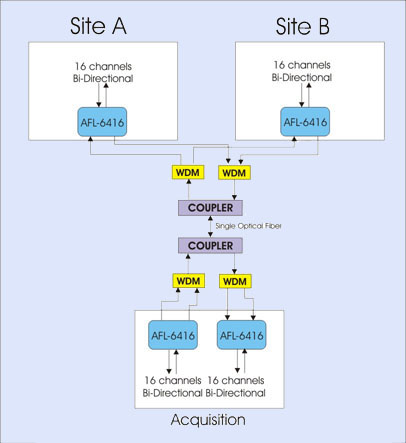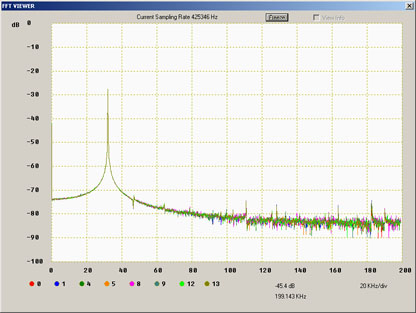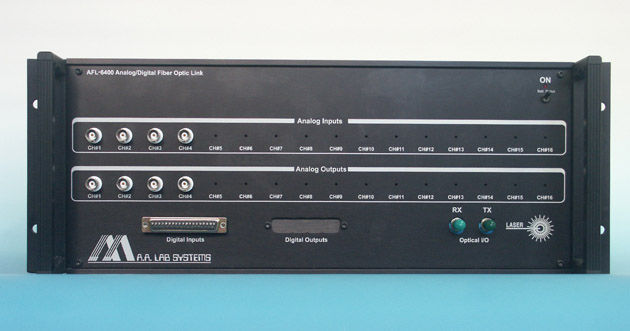High Voltage / Piezo Amplifiers & Signal Conditioners
Fiber Optic Links / Data Acquisition Systems
RF Power Amplifiers / Dual Directional Couplers
Instruments for Biological Science
Under Water Metal Detectors, Camera’s & Sonar Systems
|
Fiber Optic Links
AFL - 6400 Analog / Digital Fiber Optic Link

The AFL - 6400 is an Enhanced Fiber Optic Transmission Product Family, used for Transmission of upto 16 Analog Channels + 32 Digital Channels in Each Direction. The product is based on A/D and D/A Technique, combined with a Powerful Transceiver, for ranges of upto 100Km, at Analog Bandwidth of upto 250kHz per channel, at 16 bit Accuracy (96dB S/N Ratio). Each Unit can work back to back with the same type of unit as a Receiver / Transmitter Module (i.e. for Sending and Receiving Analog and Digital Signals to the Other Unit) or as a Powerful Data Acquisition Module, used for Acquiring Analog or Digital Data Over Long Distances, with High Accuracy and Noise Immunity. All Channels are Sampled Simultaneously to provide Correct Phase Signal for Analysis, Control and Data Acquisition Purpose.
By combining Fiber Optic Technology with Advanced Proprietary Hardware, we provide Researchers and Industry with the means to Isolate 16 Analog + 32 Digital Signals from Electrically Hostile Environment, Transmit it over upto 100km to the Data Acquisition System, while conditioning the Signal. This method eliminates the Addition of Noises generated by Electrical Machinery, Line Noises, Ground Loops and Digital Noise to your Analog Signals.
- Applications:
- Transfer an Analog Signal from a Noisy Environment
- Isolation of the Signal from High Voltage Sources
- Eliminating Ground Loops
- Accuracy and High Signal / Noise Ratio
- Bi-directional Data Acquisition and Control
- Excellent System Reliability
- Block Diagram

- Features:
- Excellent Signal Isolation.
- Prevents Ground Loops and Computer Noise Effects on your Analog Signals.
- Transfers Analog Signals to distances of upto 100km
- Linearity: Better than 0.01%.
- Low Noise: S/N Ratio (DC - 1kHz): 86dB
- Input Signal: Upto ±10V @ upto DC - 250kHz per channel, upto 16 Channels
(Max. Signal Level with No Damage: ±15V)
|

|

The following drawing describes how 2 Bi-Directional AFL - 6416 systems
can be configured together, using a single optical fiber.
- Advantages:
- Low Noise Transfer of Analog or Digital Data (such as RS-232 Interface) particularly beneficial in Electrically Noisy Environments and for Transmission over Long Distance.
- For Medical Tests: The Patient is isolated from Data Acquisition system and from any other High Voltage Source.
- Optional Instrumentation Amplifier Input Stage provides a Differential Input, with an Adjustable Gain of 10 - 2000, for Direct Connection of Any Sensor such as: Strain Gage, Piezo, EEG & ECG, Temperature, Humidity, Pressure, etc.
- Isolates Delicate Test Equipment from Computer generated Noise and Spikes: Noises from Computer do not return into your System.
- Eliminates the formation of “Ground Loops” (when Two Instruments are connected to Separate Power Lines or have a Difference between their Ground Voltage Potentials).
- Total Protection of Signal Processor's Input Stage from Accidental Sensor Malfunction (e.g. Short to Mains Voltage or a Lightning Shock).
- Replaces bulky Coaxial Cables with Compact Fiber Optic Cables - especially Important when rewiring Existing Ducts.
- Cheaper wiring (for long distances) than standard copper cable. 16 Analog channels + 32 digital channels on a Single Fiber!
- Transfers Analog and Digital Signals to distances of upto 100km - with Very High Accuracy.
Analog Inputs |
Input Voltage Range: |
-10V to +10V |
Sampling Resolution: |
16 Bit |
Noise and Hum induced in Input: |
Less than 0.1milliVolts RMS (DC - 1kHz) |
Sampling Method: |
True Simultaneous Sampling |
Analog Bandwidth: |
Is set per customer’s request |
Please note that Analog Bandwidth in NOT Half of the Sampling Rate!
Internal Low-Pass Filters are not Ideal! |
Analog Outputs |
Output Voltage Range: |
-10V to +10V |
Resolution: |
16 Bit |
Noise and Hum Induced in Output: |
Less than 150 microvolts RMS (DC - 1kHz) |
Delay from Input to Output: |
9µSecs + Filter’s Delay |
Digital Inputs and Outputs |
Number of I/O Signals: |
32 Inputs + 32 Outputs |
Sampling Rate: |
Upto 792kHz per line |
Sampling Method: |
True Simultaneous Sampling |
Delay from Input to Output: |
9µSecs Constant Delay |
Digital I/O Signals: |
Can be combined with RS-232 or RS-485 Drivers for Bi-directional Signals |
Optical Fiber: Upto 20km of Single Mode Fiber with ST connectors. 100Km Transmitters and Receivers are available as Option: 01
Link Rate: 155Mb/Sec. |
- Options:
- Option 01: High Range Fiber Optic Transmitter + Receiver - upto 100km.

- Option 02: Wavelength Multiplexer / Demultiplexer (WDM) for combining 2 Wavelengths on the same optical fiber (1310 and 1550nm). This device is useful for using multiple AFL - 6400. Devices on the same Optical Fiber or when using a Bi-directional system for Long Range (for saving fiber cost).
- Option 03: Optical Coupler for using a Single Fiber as Bi-directional link (instead of 2 fibers) or for dividing the optical data to 2 different fibers (2 outputs with the same optical signal).
- Option 04 (AFL - 6400 - USB2): A USB2 Interface to AFL - 6400 Optic Fiber. This option enables using the AFL - 6400 units as an Analog Front End, or as a part of a Data Acquisition / Monitoring system.
The USB2 Interface Card may be used to Acquire Data and Display it or Save the Data to a Host Computer. It may also function as a Transmitter to Transmit Arbitrary Digital or Analog Data to the AFL-6400 Digital or Analog Output.  A Monitoring System may be configured in Conjunction with Option 03 (AFL - 6400 Receives Analog and Digital Signals, while the Same Data is Recorded on a Host Computer). The USB-2 Interface has a Control over the Sampling Rate of the System, from the Maximum Frequency Down to 1Hz. The USB-2 Interface may be used as a Data Acquisition System with one AFL - 6400 Bi-Directional Unit, or as a “Listener” Device in a “Back to Back” configuration of 2 AFL - 6400 Units (Optical Splitter required). A Monitoring System may be configured in Conjunction with Option 03 (AFL - 6400 Receives Analog and Digital Signals, while the Same Data is Recorded on a Host Computer). The USB-2 Interface has a Control over the Sampling Rate of the System, from the Maximum Frequency Down to 1Hz. The USB-2 Interface may be used as a Data Acquisition System with one AFL - 6400 Bi-Directional Unit, or as a “Listener” Device in a “Back to Back” configuration of 2 AFL - 6400 Units (Optical Splitter required).

- Ordering Information (AFL - 6400 Modules):
Module |
Sampling Rate |
Analog Bandwidth |
AFL - 6404 (4 Bi-Directional Analog Channels + 32 Digital Channels): |
792kHz Simultaneous sampling for all Inputs and Outputs |
100kHz per channel |
AFL - 6408 (8 Bi-Directional Analog Channels + 32 Digital Channels) |
396kHz simultaneous sampling for all Inputs and Outputs |
50kHz per channel |
AFL - 6416 (16 Bi-Directional Analog Channels + 32 Digital Channels) |
198kHz simultaneous sampling for all Inputs and Outputs |
25kHz per channel |
AFL - 6404 (4 - RX/TX Uni-Directional Analog Channels + 32 Digital Channels) |
792kHz simultaneous sampling for all Inputs or Outputs |
100kHz per channel |
AFL - 6408 (8 - RX/TX Uni-Directional Analog Channels + 32 Digital Channels) |
396kHz simultaneous sampling for all Inputs or Outputs |
50kHz per channel |
AFL - 6416 (16 - RX/TX Uni-Directional Analog Channels + 32 Digital Channels) |
198kHz simultaneous sampling for all Inputs or Outputs |
25kHz per channel |
Uni-Directional Systems must be ordered in Pairs (Rx and Tx) or one side with a USB-2 Interface |

The USB-2 Interface is supported by a Data Acquisition, Calibration and Control Program
This Progream Enables the user to view the Input Signals in Real Time:

See the Spectral Analysis of the Input Signals (FFT of 2048 points):

Test the Calibration of the Input and Output Signals:

- The Program can Acquire the Analog and Digital Data to the Hard Drive and Convert it to ASCII Comma Delimited Files (for Importation to Excel, Word processors, MatLab etc.). The Program also converts those files back to Binary Files which can be sent to the AFL - 6400 and played back on the Analog and Digital Outputs (like and Analog and Digital recorder).

|

|
- AFL - 6400 - EXT: External Power Supply for system with 16 channels or Bi-Directional with 8 channels
|
AFL - 6400 - PS3: 11.3 Volts, 3A Low Noise, Linear, Regulated Power Supply (For 1 AFL - 6400 Unit)
AFL - 6400 - PS6: 11.3 Volts, 6A Low Noise, Linear, Regulated Power Supply (For 2 AFL - 6400 Units with 2 Power Outputs)
|

|
The AFL-6400 and internal circuitry is powered by a 12V, 24AH battery, which allows at least 5 hours of continuous operation. The battery may be charged by external High power charger
|
- Software
- AFL - 6400 - SW: Windows XP Data Acquisition and Control Software
- AFL - 6400 - LV: Lab View Data Acquisition and Control VI Drivers (open VI)
- EMI / RFI Protected Box:
- The AFL - 6400 can also be installed in a 19″ Rack suitable for Use in EMI/RFI Sensitive Applications. The AFL - 6400 is mounted in a 19″ Rack, made from 2mm steel, and inside it there is an Additional Mu-Metal cage to Eliminate Magnetic Interference (Mu Metal is an Alloy with Maximum Magnetic Permeability of 300,000). The EMI/RFI Input box may be configured with any number of Analog or Digital Inputs, according to Customer’s request. All I/O Lines goes through 10nF Feed-Thru Connector to eliminate any Transfer of Noise from or to the Internal Acquisition System.

- Aluminum 19″ Rack:
One or Two AFL - 6400 Units may be Installed into a 19″ Compatible Aluminum Rack Enclosure. The 19″ Enclosure Height is 4U, it is Self-Ventilated and Low Weight.

This Rack is for One Bi-Directional AFL - 6400 Unit with 4 Analog Channels and 32 Digital I/O.

This Rack is for One Uni-Directional AFL - 6400 Unit with 16 Analog Channels and 32 Digital I/O.

This Rack is for Two Uni-Directional AFL - 6400 Units with 32 Analog Channels and 64 Digital Outputs.
- I/O Board (AFL - 6400 - IO):
The I/O Board is used for Connecting External Signals to the AFL - 6400. Contains Fast Terminals (No Screws!) for all Analog and Digital Inputs and Outputs.
|
 |

|
- AFL - 6400 - RELAY - RS232:
This Board is used for Switching External Loads and Control Purposes. The Board Includes upto 16 DPDT Relays (2 On-On Contacts) for Current upto 1.5A (4A Optional) and upto 16 RS-232 Lines (upto 110kbps, Full-Duplex).
|
- External Filter Board:
The External Filter Board contains 8 Poles Anti-Aliasing Filters and Reconstruction Filters. Those Filters are designed for Enhancing the Input Bandwidth so the Unwanted Signals will be Attenuated at −60dB at 50% of the Sampling Rate (According to Nyquist's Theorem). Those Filters Ensure that there would be No Aliasing Problems of the Input Signals and that the Output Signals will have No "Stairs". Currently, those Filters are available in 3 Cutoff Frequencies:
- 150kHz for 4 Channel Systems
- 75kHz for 8 Channel Systems
- 38kHz for 16 Channel Systems
|
 |
All Specifications are subject to change without a Prior Notice
For any sort of clarifications kindly contact:
info@globesolutionz.com
|